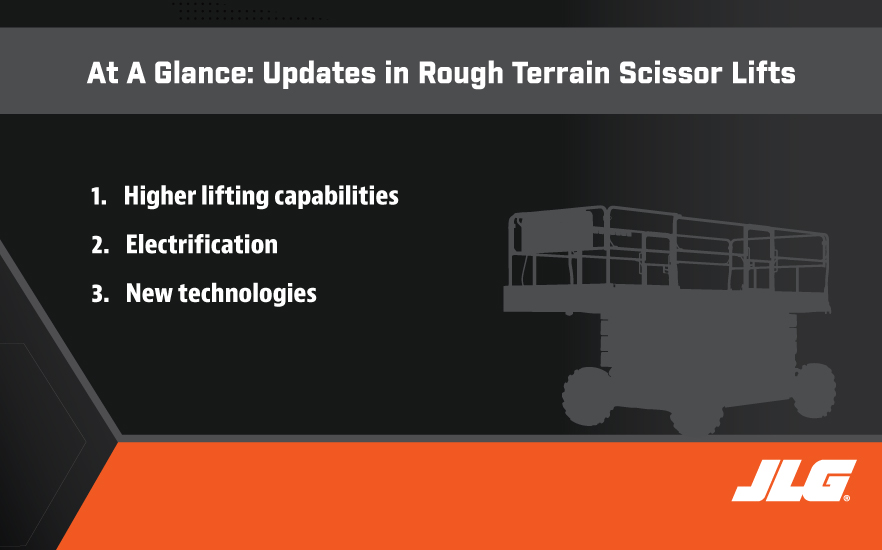 Bob Begley
Bob Begley
Director - Product Management
____
JLG Industries
In the past couple of years, JLG has announced major changes in its rough terrain scissor lifts, including a complete redesign of the product line, renaming its larger units and adding new models to the line-up.

One of the biggest benefits of these modernized machines is that today’s JLG RT/ERT lifts offer full drive at height capabilities, allowing operators to work at a fixed height along the length of a building when installing utilities inside or out. Earlier models did not offer this feature, meaning the operator would have to descend, then move the machine to the next work area, then ascend again to continue the work. The result is that these recently introduced JLG models, which allow work at a fixed height, offer exceptional productivity benefits.
But, full drive at height capabilities isn’t the only new benefit JLG’s updated scissor lifts offer customers. We believe there are three trends that will significantly change machine design in the coming years — 1) higher lifting capabilities, 2) electrification and 3) new technologies, and JLG’s rough terrain (RT) and electric rough terrain (ERT) scissor lifts are already in position to meet the market’s demand.
Let’s take a closer look…
1. Higher lifting capabilities
With building footprints getting narrower and taller, customers are looking for equipment that offers greater lift height. Users also want to bring more materials and people to the work area, which drives the need for higher capacity.
JLG RT/ERT scissor lifts are well-suited for this type of work because of their large platform. They offer 28-percent more working area than competitive models with class-leading capacities. JLG’s models are designed with zero-platform offset to minimize the distance users must reach to access the work area. And, to navigate through tight spaces more efficiently, these JLG machines are equipped with easy-fold rails, which can be collapsed in three minutes or less.
2. Electrification
Due to an increase in demand for electric-powered lifts globally, when JLG announced its fully redesigned rough terrain scissor line in early 2020, it included both engine-powered RT and electric-powered ERT models in each size class.
We expect to see electric models continue to gain popularity as battery technology advances and environmental considerations become more and more stringent. For example, when JLG introduced the world’s first all-electric slab scissor lift model, the JLG AE1932 DaVinci® lift in 2021, it was engineered as the first-of-a-kind lift with zero hydraulics, thereby eliminating the potential for leaks, and powered by a single lithium-ion battery that recharges as the lift descends to lengthen the operational time between charges. We believe some of these same market-leading technologies will grow in popularity and that over time customers will request they be included in other models.
3. New technologies
We also see a need in the rough terrain scissor lift market for new technologies to solve the most common job site challenges.
For example, the redesigned JLG RT/ERT lines are equipped with LiftSense™, a standard and exclusive JLG feature, which shows operators the maximum work height that can be achieved before they elevate based on side-to-side and front-to-back tilt, as well as the current capacity in the platform. This means that operators can see if they should take a little bit less material with them or if they need to get to a spot that's a little bit more level on the job site so that they can get the full height — it removes the guesswork that often results in operators having to descend and try again for marked productivity gains.
New technology on JLG RT models includes a QuikLevel Advanced feature, which automatically levels the machine on side slopes up to 4.5 degrees while allowing the operator to drive at full height under certain conditions. The machine’s sensors monitor platform load, platform height, front axle tilt, rear axle tilt, and chassis tilt, then automatically level the lift based on ground conditions.
What’s coming next?
As construction activity is accelerating in North America, we anticipate the current strong, steady demand for rough terrain scissor lifts to continue. That’s because, despite utilization varying based on seasonality and concentration of construction activity in and around an area, these machines continue to be common job site tools thanks to their ability to expand users’ capabilities whether working on-slab or off.
So, what do we see coming next for rough terrain scissor lifts? Like slab models, we are striving for rough terrain scissor lifts to become efficient for use in/around sensitive environments (data centers, hospitals, laboratories, industrial chemical facilities) and in extreme environments (below-freezing or high heat temperatures.
Interesting in learning more about what’s new with JLG rough terrain scissor lifts? For more information, click here.
Do you want to stay up-to-date with industry news and issues similar to this? Make sure you subscribe below to receive monthly updates from #DirectAccess with newly posted content so you never miss important information.